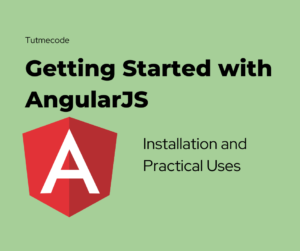Vue.js is a popular JavaScript framework that is widely used for building dynamic and interactive web applications. It offers a simple and intuitive approach to building user interfaces and provides powerful features for handling data, events, and components. In this article, we will cover the latest version of Vue.js and provide detailed explanations along with examples to help beginners understand and apply its core concepts effectively.
1. Reactive Vue Data
Reactivity is one of the key features of Vue.js. The framework automatically tracks changes in data and updates the DOM accordingly. To create reactive data in Vue, you can define properties within the data object of a Vue instance. Let’s look at an example.
<template>
<div>
<p>{{ message }}</p>
<button @click="changeMessage">Change Message</button>
</div>
</template>
<script>
export default {
data() {
return {
message: "Hello, Vue!"
};
},
methods: {
changeMessage() {
this.message = "New message!";
}
}
};
</script>
2. Displaying Data
Vue.js provides a declarative way to display data in the HTML template using double curly braces {{ }}. You can bind data directly to elements and expressions within the template. Here’s an example.
<template>
<div>
<h1>{{ title }}</h1>
<p>{{ description }}</p>
</div>
</template>
<script>
export default {
data() {
return {
title: "Vue.js Beginners Guide",
description: "Learn the fundamentals of Vue.js and build interactive applications."
};
}
};
</script>
3. Form Data Collection
Vue.js simplifies form handling by providing two-way data binding. You can bind form input elements directly to data properties and automatically update the data when the input value changes. Here’s an example.
<template>
<div>
<input v-model="name" type="text" placeholder="Enter your name">
<p>Your name is: {{ name }}</p>
</div>
</template>
<script>
export default {
data() {
return {
name: ""
};
}
};
</script>
4. Displaying Data Sets
Vue.js allows you to iterate over arrays or objects using directives like v-for to dynamically display data sets. Let’s consider an example of rendering a list of items.
<template>
<div>
<ul>
<li v-for="item in items" :key="item.id">{{ item.name }}</li>
</ul>
</div>
</template>
<script>
export default {
data() {
return {
items: [
{ id: 1, name: "Item 1" },
{ id: 2, name: "Item 2" },
{ id: 3, name: "Item 3" }
]
};
}
};
</script>
5. Event Handling
Vue.js provides easy event handling by using the v-on directive or shorthand @. You can listen to events and execute methods defined in the Vue instance. Here’s an example.
<template>
<div>
<button @click="handleClick">Click me</button>
</div>
</template>
<script>
export default {
methods: {
handleClick() {
console.log("Button clicked!");
}
}
};
</script>
6. Components
Components are the building blocks of Vue.js applications. They allow you to create reusable and modular pieces of code. You can encapsulate HTML templates, JavaScript logic, and styles within a component. Let’s create a simple component.
<template>
<div>
<h2>{{ title }}</h2>
<p>{{ description }}</p>
</div>
</template>
<script>
export default {
data() {
return {
title: "MyComponent",
description: "This is a custom component"
};
}
};
</script>
7. Props
Props enable you to pass data from a parent component to a child component. This allows for better code organization and reusability. Here’s an example of using props:
Parent Component.
<template>
<div>
<ChildComponent message="Hello from parent!" />
</div>
</template>
<script>
import ChildComponent from './ChildComponent.vue';
export default {
components: {
ChildComponent
}
};
</script>
Child Component (ChildComponent.vue):
<template>
<div>
<p>{{ message }}</p>
</div>
</template>
<script>
export default {
props: ['message']
};
</script>
8. Component Reusability
Vue.js promotes component reusability, allowing you to use the same component multiple times within a single application or across different projects. By defining clear and independent components, you can easily maintain and extend your codebase.
9. Asynchronous API Calls
Vue.js provides various options for making asynchronous API calls, such as using the Axios library or built-in fetch API. These methods enable you to retrieve data from servers and update your application accordingly. Here’s an example of using Axios.
<template>
<div>
<ul>
<li v-for="user in users" :key="user.id">{{ user.name }}</li>
</ul>
</div>
</template>
<script>
import axios from 'axios';
export default {
data() {
return {
users: []
};
},
mounted() {
axios.get('/api/users')
.then(response => {
this.users = response.data;
})
.catch(error => {
console.error(error);
});
}
};
</script>
10. JWT Authentication
JSON Web Token (JWT) is a popular authentication mechanism. Vue.js can work seamlessly with JWT-based authentication systems. You can store JWT tokens in the browser’s local storage or cookies and send them with each API request to authenticate users.
11. Login & Signup
Implementing user login and signup functionality involves handling form inputs, validating user credentials, and interacting with backend APIs. Vue.js provides a solid foundation for building these authentication features, and you can incorporate your preferred backend technology to handle user management.
12. Pagination
In applications that display large sets of data, pagination is crucial to provide a better user experience. Vue.js allows you to implement pagination by manipulating the displayed data based on the selected page. You can use libraries like vue-pagination to simplify the implementation process.
13. Loading State
During asynchronous operations, it’s common to display loading indicators to provide feedback to users. Vue.js makes it easy to manage loading states using data properties and conditional rendering. You can show loading spinners or placeholders while waiting for data to load.
14. Error Handling
Error handling is an essential part of any application. Vue.js enables you to catch errors during API requests, form submissions, or any other operation. You can display error messages to users and handle different error scenarios gracefully.
15. Frontend CSS Frameworks Integration
Vue.js seamlessly integrates with popular front-end CSS frameworks like Bootstrap, Tailwind CSS, and Vuetify. These frameworks provide pre-designed components and styling options, allowing you to build visually appealing applications quickly.
16. Vue CLI
Vue CLI is a command-line interface tool that simplifies Vue.js project setup and development. It provides a standardized project structure, a built-in development server, and various configuration options. Using Vue CLI, you can scaffold new projects and manage dependencies effortlessly.
17. Application Deployment
After building your Vue.js application, you need to deploy it to a production environment. Vue.js applications can be deployed as static files, served by web servers, or integrated with backend frameworks. Popular deployment options include using platforms like Netlify, and Heroku, or hosting the application on your own server.
Conclusion:
Vue.js offers a beginner-friendly approach to building interactive web applications. This article covered essential topics for beginners, including reactive data, displaying data, form data collection, event handling, components, props, component reusability, asynchronous API calls, JWT authentication, login and signup functionality, pagination, loading state, error handling, frontend CSS frameworks integration, Vue CLI, and application deployment. By mastering these concepts, you’ll be equipped to build powerful and modern web applications using Vue.js.




